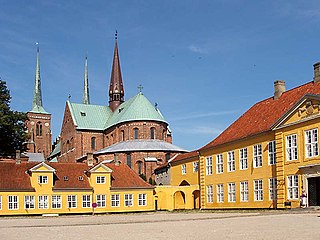
Roskilde, located 30 km (19 mi) west of Copenhagen on the Danish island of Zealand, is the main city in the eponymous municipality. With a population of 51,793, the city is a business and educational centre for the region and the 10th largest city in Denmark. It is governed by the administrative council of Roskilde Municipality.
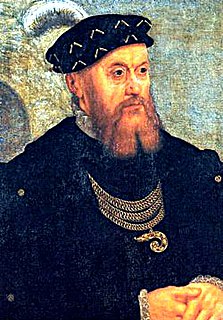
Christian III reigned as King of Denmark from 1534 and King of Norway from 1537 until his death in 1559. During his reign, Christian formed close ties between the church and the crown. He established Lutheranism as the state religion within his realms as part of the Protestant Reformation.

Valdemar I, also known as Valdemar the Great, was King of Denmark from 1154 until his death in 1182. The reign of King Valdemar I saw the rise of Denmark, which reached its high medieval zenith under his son King Valdemar II.
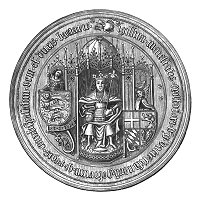
Christopher of Bavaria was King of Denmark, Sweden (1441–48) and Norway (1442–48) during the era of the Kalmar Union.

The Treaty of Roskilde was concluded on 26 February (OS) or 8 March 1658 (NS) during the Second Northern War between Frederick III of Denmark–Norway and Karl X Gustav of Sweden in the Danish city of Roskilde. After a devastating defeat, Denmark–Norway was forced to give up a third of its territory to save the rest, the ceded lands comprising Blekinge, Bornholm, Bohuslän (Båhuslen), Scania (Skåne) and Trøndelag, as well as her claims to Halland.

At the outset of World War II in September 1939, Denmark declared itself neutral. For most of the war, the country was a protectorate and then an occupied territory of Germany. The decision to occupy Denmark was taken in Berlin on 17 December 1939. On 9 April 1940, Germany occupied Denmark in Operation Weserübung. The Danish government and king functioned as relatively normal in a de facto protectorate over the country until 29 August 1943, when Germany placed Denmark under direct military occupation, which lasted until the Allied victory on 5 May 1945. Contrary to the situation in other countries under German occupation, most Danish institutions continued to function relatively normally until 1945. Both the Danish government and king remained in the country in an uneasy relationship between a democratic and a totalitarian system until the Danish government stepped down in a protest against German demands to institute the death penalty for sabotage.

The Danish resistance movements were an underground insurgency to resist the German occupation of Denmark during World War II. Due to the initially lenient arrangements, in which the Nazi occupation authority allowed the democratic government to stay in power, the resistance movement was slower to develop effective tactics on a wide scale than in some other countries.
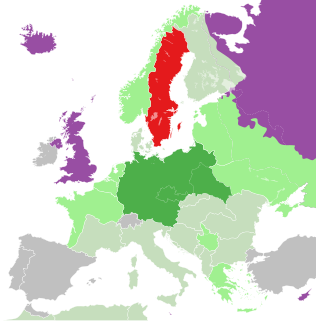
Sweden maintained its policy of neutrality during World War II. When the war began on 1 September 1939, the fate of Sweden was unclear. But by a combination of its geopolitical location in the Scandinavian Peninsula, realpolitik maneuvering during an unpredictable course of events, and a dedicated military build-up after 1942, Sweden kept its official neutrality status throughout the war. At the outbreak of hostilities, Sweden had held a neutral stance in international relations for more than a century, since the end of the Napoleonic Wars in 1814 and the invasion of Norway.

The Royal Danish Army is the land-based branch of the Danish Defence, together with the Danish Home Guard. For the last decade, the Royal Danish Army has undergone a massive transformation of structures, equipment and training methods, abandoning its traditional role of anti-invasion defence, and instead focusing on out of area operations by, among other initiatives, reducing the size of the conscripted and reserve components and increasing the active component, changing from 60% support structure and 40% operational capability, to 60% combat operational capability and 40% support structure. When fully implemented, the Danish army will be capable of deploying 1,500 troops permanently on three different continents continuously, or 5,000 troops for a shorter period of time, in international operations without any need for extraordinary measures such as parliamentary approval of a war funding bill.
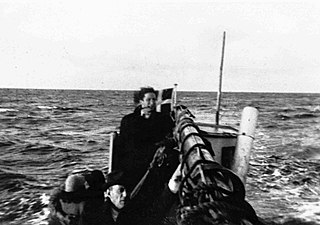
The Danish resistance movement, with the assistance of many Danish citizens, managed to evacuate 7,220 of Denmark's 7,800 Jews, plus 686 non-Jewish spouses, by sea to nearby neutral Sweden during the Second World War. The arrest and deportation of Danish Jews was ordered by the German leader Adolf Hitler, but the efforts to save them started earlier due to the plans being leaked on September 28, 1943 by German diplomat Georg Ferdinand Duckwitz.

The German invasion of Denmark, sometimes known as the Six Hour War due to the short length, was the German attack on Denmark on 9 April 1940, during the Second World War. The attack was a prelude to the invasion of Norway.

The Swedish Empire was a European great power that exercised territorial control over much of the Baltic region during the 17th and early 18th centuries. The beginning of the empire is usually taken as the reign of Gustavus Adolphus, who ascended the throne in 1611, and its end as the loss of territories in 1721 following the Great Northern War.
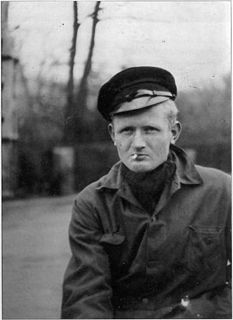
Bent Faurschou Hviid was a member of the Danish resistance group Holger Danske during World War II. He was quickly named "Flammen", for his red hair. In 1951, he and his Resistance partner Jørgen Haagen Schmith, were posthumously awarded the United States Medal of Freedom by President Harry Truman.
Events from the year 1943 in Denmark.

Operation Weserübung was Germany's assault on Denmark and Norway during the Second World War and the opening operation of the Norwegian Campaign.
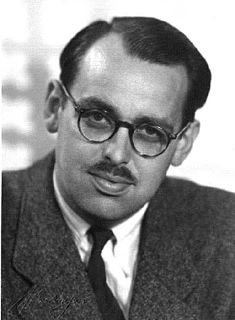
Jørgen Haagen Schmith, better known under the codename Citronen, was a renowned fighter in the Danish resistance movement during the German Occupation of Denmark of 1940-45. In 1951 he and his partner Bent Faurschou Hviid were posthumously awarded the United States Medal of Freedom by President Harry Truman.

The Dano–Swedish War of 1808–1809 was a war between Denmark–Norway and Sweden due to Denmark–Norway's alliance with France and Sweden's alliance with the United Kingdom during the Napoleonic Wars. Neither Sweden nor Denmark-Norway had wanted war to begin with but once pushed into it through their respective alliances, Sweden made a bid to acquire Norway by way of invasion while Denmark-Norway made ill-fated attempts to reconquer territories lost to Sweden in the 17th century. Peace was concluded on grounds of status quo ante bellum on 10 December 1809.

The M/1923 helmet was a combat helmet issued to Danish troops during the interwar period and saw service in the Second World War. It was the first helmet to be issued to the Royal Danish Army and Navy. The helmet was produced locally by the company A/S Glud & Marstrands Fabrikker.
Harald Sandbæk was a Danish theologian, author and resistance fighter. He culminated his career as provost of Holmen, Copenhagen, from 1962 to 1973. During the German occupation of Denmark in the Second World War, he was a member of the Danish resistance in Aarhus before joining Den Danske Brigade in Sweden.

Operation Safari was a German military operation during World War II aimed at disarming the Danish military. It led to the scuttling of the Royal Danish Navy and the internment of all Danish soldiers. Danish forces suffered 23–26 dead, around 40–50 injured, and 4,600 captured. Of the roughly 9,000 Germans involved, one was killed and eight wounded, although the number may have been 11 killed and 59 wounded.
























